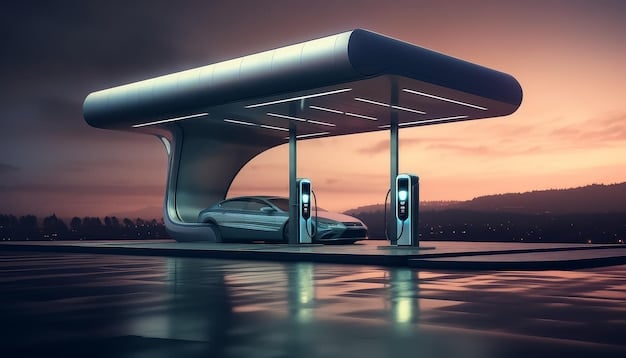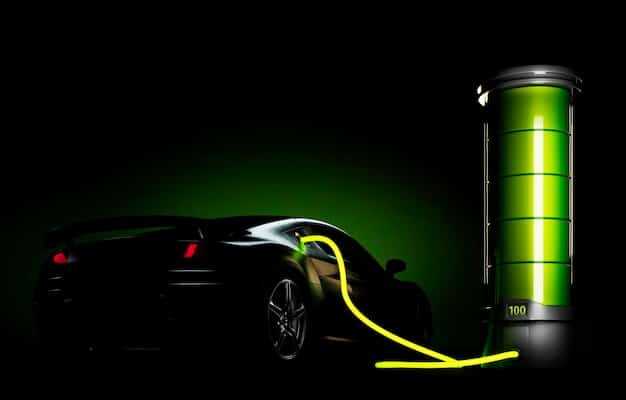Battery Tech Advances & EV Market Impact in 2025

Advertisements
Advanced battery technologies, specifically solid-state and lithium-sulfur, are poised to revolutionize the electric vehicle market by offering increased range, faster charging, and enhanced safety, fundamentally altering future automotive landscapes.
Advertisements
The electric vehicle (EV) market is currently undergoing a transformative period, driven largely by continuous innovation in battery technology. Understanding what are the latest developments in battery technology and how will they impact the electric vehicle market is crucial for anyone keen on the future of transportation. These advancements promise not only to address existing limitations but also redefine the possibilities for sustainable mobility.
The Push for Enhanced Energy Density
The continuous quest for higher energy density in batteries is at the forefront of development. Increasing energy density means fitting more power into a smaller, lighter package. This directly translates to longer driving ranges for electric vehicles, alleviating range anxiety, a significant barrier for many potential EV buyers. Researchers are exploring novel material compositions and architectural designs to achieve these gains.
Advertisements
Higher energy density brings multiple benefits. Beyond extended range, it also reduces the overall weight of the battery pack, which improves vehicle efficiency and handling. The drive for density often involves trade-offs, such as material costs or cycle life, prompting extensive research into optimizing these factors for practical applications.
Solid-State Batteries: The Holy Grail?
Solid-state batteries are frequently heralded as the next big leap. Unlike conventional lithium-ion batteries that use liquid electrolytes, solid-state batteries utilize solid materials, most commonly ceramics or specialized polymers. This fundamental change offers several compelling advantages.
- Enhanced Safety: Solid electrolytes are non-flammable, significantly reducing the risk of thermal runaway and fires, a critical safety concern with current EV batteries.
- Higher Energy Density: They can store more energy in the same volume, potentially offering up to 800-1000 Wh/L, far surpassing the 250-300 Wh/L of current lithium-ion cells.
- Faster Charging: Solid-state designs can theoretically handle higher current densities, allowing for ultra-fast charging times, possibly reaching 80% charge in under 15 minutes.
- Longer Lifespan: Reduced degradation mechanisms could lead to significantly longer cycle lives, meaning batteries would last for hundreds of thousands of miles.
Many major automotive manufacturers, including Toyota, Nissan, and Volkswagen, are heavily investing in solid-state battery research and development, with prototypes already showing promising results. The primary challenges remain scaling production and reducing manufacturing costs to make them commercially viable for mass market adoption.
The integration of solid-state technology into EVs could fundamentally change the consumer perception of electric cars, making them a more appealing and practical alternative to gasoline-powered vehicles. The shift from liquid to solid electrolytes represents an engineering marvel, promising a safer and more powerful energy storage solution.
Rapid Charging and Longer Lifespan Technologies

Beyond energy density, advancements in charging speed and battery longevity are critical for widespread EV adoption. Consumers demand convenience similar to gasoline refueling and batteries that can last the lifetime of the vehicle without significant degradation.
Innovations in anode and cathode materials are enabling faster charge rates. Silicon-based anodes, for example, can absorb lithium ions more quickly than traditional graphite anodes, facilitating rapid energy transfer. Similarly, new cathode chemistries are being developed to withstand aggressive charging cycles without compromising structural integrity.
Improving battery lifespan involves mitigating degradation mechanisms. Factors such as dendrite formation, electrolyte decomposition, and electrode structural changes reduce a battery’s capacity and power over time. Research is focusing on protective coatings for electrodes, advanced electrolyte formulations, and sophisticated battery management systems (BMS) that optimize charging and discharging cycles to extend cell life significantly. This will translate into EVs that maintain their performance for many more years and miles.
Enhanced Battery Management Systems (BMS)
Modern electric vehicles rely heavily on sophisticated Battery Management Systems. These are not merely monitoring tools; they are complex algorithms and hardware that actively manage the battery’s health and performance. Advanced BMS can predict degradation, optimize charging profiles based on real-time conditions, and balance cell voltages to ensure uniform wear across the battery pack. This proactive management prevents individual cells from being overstressed, thereby extending the overall lifespan of the battery.
The role of artificial intelligence and machine learning in BMS is expanding. AI-powered systems can analyze vast amounts of data from battery usage, temperature fluctuations, and charging patterns to refine their management strategies. This leads to more efficient energy utilization, better thermal management, and a deeper understanding of battery aging, enabling predictive maintenance and even customized charging recommendations for individual users.
These intelligent systems allow automotive manufacturers to offer longer battery warranties, instilling greater confidence in consumers regarding the long-term viability of their EV investment. Furthermore, a well-managed battery can retain a higher residual value, contributing to a more sustainable circular economy for EVs.
Addressing Raw Material Concerns: Alternative Chemistries
The global demand for lithium, cobalt, and nickel, key components in current lithium-ion batteries, raises concerns about supply chain stability, ethical sourcing, and environmental impact. This has spurred significant research into alternative battery chemistries that reduce or eliminate reliance on these critical materials.
Sodium-ion (Na-ion) batteries are emerging as a compelling alternative. Sodium is abundant and less costly than lithium, and the technology shares many similarities with existing lithium-ion production. While currently offering lower energy density than lithium-ion, Na-ion batteries are suitable for shorter-range urban EVs, stationary energy storage, and could complement longer-range vehicles. Their performance at low temperatures also makes them attractive for diverse climates.
Lithium-sulfur (Li-S) batteries present another promising avenue. Sulfur is cheap, abundant, and environmentally benign. Li-S batteries boast theoretical energy densities significantly higher than lithium-ion, potentially offering double the range for the same weight. Challenges include the rapid degradation of the sulfur cathode and lithium anode, but ongoing research is making strides in improving their cycle life and stability. If these hurdles are overcome, Li-S could be a game-changer for long-range EVs and even electric aviation.
Developing Cobalt-Free Cathodes
Cobalt is particularly problematic due to its volatile pricing, often unethical mining practices, and geographical concentration. Efforts to reduce or entirely eliminate cobalt from battery cathodes are intensively underway. Lithium iron phosphate (LFP) batteries, which are naturally cobalt-free, are gaining significant traction, particularly in China. While LFP batteries traditionally have lower energy densities, advancements are improving their performance, making them increasingly competitive.
Other research focuses on high-nickel manganese or other transition metal oxides that minimize cobalt content while maintaining high energy density. Companies are actively exploring various chemistries, such as those relying more heavily on iron and manganese, to diversify their material sourcing and reduce their supply chain risks. The shift towards cobalt-free or low-cobalt chemistries is driven by both ethical considerations and the strategic imperative to secure more stable and sustainable supply chains for the booming EV market.
These alternative chemistries are not just about raw materials; they represent a holistic approach to making batteries more sustainable, affordable, and adaptable to various applications. Diversifying the battery portfolio ensures resilience and continuous innovation in the face of resource constraints and environmental pressures.
Impact on Electric Vehicle Performance and Cost
The confluence of these battery technology developments will profoundly impact the performance and cost of electric vehicles. As energy density increases and charging times decrease, EVs will become more practical and attractive to a wider consumer base. Range anxiety will diminish, and the convenience of charging will rival or even surpass traditional refueling.
The long-term total cost of ownership for EVs is also set to improve. More durable batteries with longer lifespans will reduce the need for costly replacements. Furthermore, increased competition and advancements in manufacturing processes, especially for new chemistries like solid-state and sodium-ion, are expected to drive down battery pack costs. This cost reduction is crucial for achieving price parity with internal combustion engine (ICE) vehicles, making EVs accessible to a larger market segment.
The potential for bi-directional charging (Vehicle-to-Grid or V2G) is also enhanced by these advancements. As batteries become more robust and intelligent, EVs can serve as mobile energy storage units, feeding power back into the grid during peak demand or even powering homes during outages. This integration turns EVs into valuable assets beyond just transportation, further enhancing their utility and economic appeal.
Enhanced Range and Charging Infrastructure Synergy
Improved battery ranges mean less frequent charging stops, which, when combined with faster charging technologies, significantly enhances the overall user experience. This synergistic effect lessens the reliance on an extensive, ubiquitous charging infrastructure for long-distance travel, allowing for strategic placement of high-speed chargers along major routes. As battery capacity grows, a quick top-up during a rest stop could add hundreds of miles of range, making cross-country EV travel seamless.
Furthermore, the increased efficiency of newer battery types results in less energy waste during charging and discharging, contributing to a lower carbon footprint for the entire EV ecosystem. This holistic improvement in performance from enhanced batteries will inevitably lead to a larger market share for electric vehicles, accelerating the global transition away from fossil fuels. The evolution of battery technology is therefore a central pillar supporting the broader expansion and maturation of the EV market.
Sustainable Practices and Recycling
As the electric vehicle market expands, the sustainability of battery production and end-of-life management becomes increasingly critical. The industry is moving towards more responsible sourcing of raw materials, minimizing environmental impact, and ensuring ethical labor practices. This includes certifications for cobalt and lithium mining, and increased transparency across the supply chain.
Recycling EV batteries is a key area of focus. Current recycling processes primarily recover valuable metals like cobalt, nickel, and copper. However, new technologies are being developed to efficiently recover all battery components, including lithium, graphite, and various plastics, ensuring a truly circular economy. Direct recycling methods, which aim to retain the molecular structure of the cathode material, show promise for higher purity and lower energy consumption compared to traditional pyrometallurgical or hydrometallurgical processes.
Batteries that are no longer suitable for EVs can also find a second life in stationary energy storage applications, often referred to as “second-life batteries.” These batteries can still retain 70-80% of their original capacity, making them ideal for grid stabilization, renewable energy integration, or commercial backup power. This repurposing extends their useful life, reduces waste, and defers the need for full recycling, further enhancing the overall sustainability of battery technology.
Battery Passport and Traceability Initiatives
To improve transparency and accountability within the battery supply chain, initiatives like the “Battery Passport” are being developed. A digital battery passport would contain comprehensive information about a battery’s origin, materials, manufacturing history, performance characteristics, and carbon footprint. This initiative aims to provide consumers and regulators with detailed insights into the battery’s journey, from raw material extraction to end-of-life. By making this information readily available, it promotes responsible sourcing and sustainable production practices. The Battery Passport is expected to become a standard requirement in several markets, driving manufacturers to adopt more ethical and environmentally friendly processes throughout their supply chains.
Regulatory Landscape, Policy, and Infrastructure
Government policies and regulatory frameworks play a crucial role in accelerating the adoption of new battery technologies and electric vehicles. Incentives for EV purchases, investments in charging infrastructure, and stricter emissions standards are creating a conducive environment for market growth. These policies often align with broader climate goals, encouraging manufacturers to innovate and consumers to switch to cleaner transportation options.
The development of a robust charging infrastructure is paramount. This includes expanding public charging networks, encouraging home charging solutions, and implementing smart grid technologies capable of handling increased electricity demand from EVs. Governments and private entities are collaborating to deploy high-power charging stations along major highways and in urban centers, ensuring range confidence for drivers.
Furthermore, regulations regarding battery safety, performance standards, and end-of-life recycling are evolving to ensure that new technologies are deployed responsibly. These policies help foster public trust in EVs and promote sustainable practices across the entire value chain. Standardization efforts for charging connectors and communication protocols are also critical to ensure interoperability and a seamless user experience across different vehicle brands and charging networks.
Global Collaboration in Battery Research
The complexity and capital intensity of battery research necessitate significant global collaboration. Academic institutions, private companies, and government research bodies from different countries are increasingly pooling resources and expertise to accelerate breakthroughs. This collaborative approach helps in sharing knowledge, avoiding duplication of efforts, and establishing common standards that can benefit the entire industry. International consortia and joint ventures are frequently formed to tackle specific challenges, such as developing next-generation solid-state electrolytes or scaling up new manufacturing processes.
Such global cooperation not only speeds up scientific discovery but also aids in establishing a resilient and diverse supply chain for battery materials, reducing dependence on any single region for critical resources. This interconnected research community ensures that the best ideas and innovations can emerge from anywhere in the world and be rapidly disseminated and adopted, ultimately benefiting the global energy transition.
Future Outlook and Concluding Thoughts
The trajectory of battery technology suggests a future where electric vehicles are not just an alternative but the dominant form of personal and commercial transportation. The continuous advancements in energy density, charging speed, safety, and lifespan, coupled with efforts to address raw material concerns, are systematically removing existing barriers to widespread adoption. The electric vehicle market will become ever more competitive, offering a diverse array of models that cater to various consumer needs and budgets.
Looking ahead, we can anticipate a future where EVs offer ranges comparable to or exceeding gasoline cars, charge in the time it takes to grab a coffee, and potentially even double as mobile power banks for homes and grids. The transition will also be fueled by increasing sustainability in battery production and a robust ecosystem for recycling and second-life applications. The convergence of technological innovation, supportive policies, and evolving consumer preferences positions battery technology as a cornerstone of a cleaner, more sustainable future of mobility. The impact will extend beyond just transportation, influencing energy grids, urban planning, and resource management on a global scale. The next few years promise to be incredibly exciting as these developments mature and become mainstream.
| Key Point | Brief Description |
|---|---|
| ⚡ Solid-State Batteries | Promise higher energy density, faster charging, and enhanced safety for EVs. |
| 🔋 Material Diversification | Focus on sodium-ion and cobalt-free chemistries to address resource concerns. |
| 🔄 Enhanced Lifespan & BMS | Advanced battery management systems extend battery life and optimize performance. |
| ♻️ Sustainability & Recycling | Growing focus on ethical sourcing, comprehensive recycling, and second-life applications. |
Frequently Asked Questions About EV Battery Technology
▼
Solid-state batteries are widely considered the most promising next-generation technology. Their potential for higher energy density, faster charging capabilities, and significantly improved safety due to non-flammable solid electrolytes makes them a key focus for major automotive manufacturers and battery developers seeking to revolutionize the EV market.
▼
New technologies like solid-state and lithium-sulfur batteries are expected to drastically increase EV driving ranges, potentially surpassing 500 miles on a single charge. Simultaneously, advancements in cell chemistry and thermal management aim to reduce charging times significantly, with ultra-fast charging allowing an 80% charge in less than 15 minutes in some future models.
▼
Yes, several alternatives are under active development. Sodium-ion (Na-ion) batteries are gaining traction due to the abundance and lower cost of sodium. Lithium-sulfur (Li-S) batteries offer much higher theoretical energy densities. Additionally, ongoing research focuses on reducing or eliminating problematic materials like cobalt, leading to cobalt-free chemistries such as advanced lithium iron phosphate (LFP).
▼
Sustainability is a major focus. Companies are investing in more ethical and environmentally responsible sourcing of raw materials, improving recycling processes to recover valuable components, and exploring “second-life” applications for EV batteries in stationary energy storage. Initiatives like the “Battery Passport” aim to enhance transparency and traceability throughout the supply chain.
▼
Advanced Battery Management Systems are crucial. They intelligently monitor and optimize battery performance, manage charging and discharging cycles, balance cell voltages, and predict degradation. AI and machine learning are increasingly integrated into BMS to extend battery lifespan, enhance safety, and enable functionalities like vehicle-to-grid (V2G) power transfer, maximizing utility.
Conclusion
The continuous and rapid evolution of battery technology is not just an incremental improvement; it is a fundamental pillar driving the electric vehicle revolution. From the promising advent of solid-state and lithium-sulfur chemistries to the critical development of sustainable raw material alternatives and sophisticated battery management systems, each advancement contributes to a more efficient, safer, and cost-effective EV ecosystem. These developments will undoubtedly reshape the automotive industry, making electric vehicles a more compelling and accessible choice for consumers worldwide, accelerating our transition towards a cleaner, more sustainable future of transportation.






